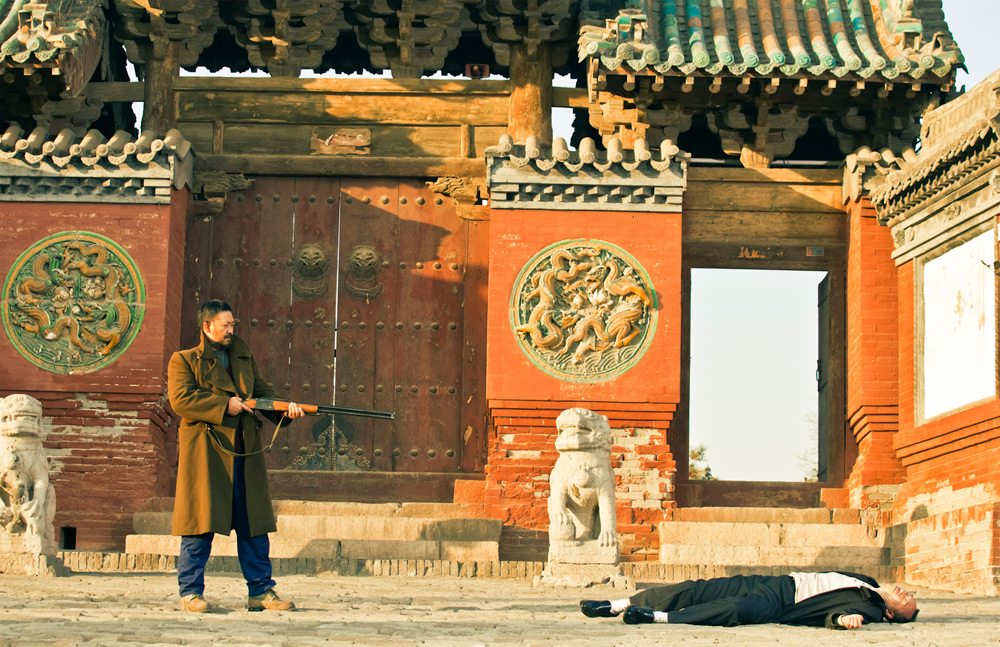With A Touch of Sin, Chinese auteur Jia Zhangke deviates slightly from his social-realist vein of the last 15 years. Like his other works (24 City, Still Life), A Touch of Sin offers a damning critique of contemporary Chinese society, one inspired by true events from daily headlines. This time, however, the unmistakable presence of anger and violence—the latter presented in slick, stylistic maneuverings that sometimes almost seem to betray the heavy themes at hand—underscores the dehumanizing aspect of daily life for many Chinese people. Split into four narratives that take place across the nation, A Touch of Sin offers a cross-section of systematic crime and corruption, the humiliation and debasement of its protagonists, and the urgency and desperation with which they resort to violent acts.
Jia and his wife, the actress Zhao Tao, who appears in many of his films, sat down with us during the recent Toronto International Film Festival. We talked about A Touch of Sin, and in particular, one memorable scene in which Zhao’s character, who is repeatedly abused by a client, decides to fight back.
GFW: The scene in which your character finally gets revenge is a highly charged one. Had you encountered anything like this before in your career, a role that similarly required so much physical precision and emotion?
Zhao: The role in the trajectory of my career is singular and I’ve never played anything this violent. I’m a perpetrator of violence in this film. I’ve been trained in martial arts for a previous role. And so when I yielded the sword for the revenge scene that you mention, it was very thrilling, personally, but I also feel this was the most tragic character I’ve ever played. In that moment of violence there is no one who can help the character but herself.
What did you find more difficult: preparing yourself emotionally or the physical aspect, the choreography?
Zhao: It was definitely the emotional element, because I’ve never encountered such violence before personally, and therefore in order to prepare for this role I had to first believe that such violence can exist and that was very difficult to accept. When I watched the film at the Cannes premiere I felt this unforgettable and inexplicable pain and empathy for people who do experience these violent acts.
Jia, how did you end up casting Zhao in the film? Did you write the character with her in mind?
Jia: The consideration for casting Zhao is complex and required measuring whether or not she would feel emotionally and spiritually connected to the role. In order to feel the balance of emotional and spiritual despair of the character, it was difficult because Tao is a person with a lot of self respect. So it was a challenge directing the scene. And then there was the physical aspect of the role, because throughout the course of the narrative she becomes a warrior, a wuxia warrior. With her background in dance and previous training I trusted that it was possible.
Since 2004 your films have been released theatrically in China. What do you believe the reception will be like in your home country, especially with regards to its violent scenes?
Jia: Audiences will indeed be shocked because with what is shown in China there are no direct acts of violence portrayed in this way. So the contradiction, of course, is that the violence is frequently depicted in the news in a didactic way. But in an artistic way, not at all. It hasn’t been narrativized or captured in cinema or described in the art world. Socially, this means people have not really reflected on a deeper level upon the roots and background that leads to this kind of violence that is happening in society. And the purpose of this film is partially to observe, examine and reflect upon these roots.
Do you think audiences in China will understand these intentions, or do you think they will see the violence solely as stylistic markers?
Jia: I wish and hope that the local audiences in China will not read it mere stylistic markers. The purpose of forming the four narrative strands within this film, with the structure of this film, is to portray these stories as not isolated incidents but rather together, as a collective phenomenon of violence in China.
What was the writing process like? How did you decide to structure the story? How did you choose which story would come first, the duration of each story, and how you would link each one thematically?
Jia: The structure was ordered around Chinese New Year. The first section of the story occurs in the winter, the second part occurs during Chinese New Year, the third part occurs when people begin to go back to work. And then the last part is after that. The reason I decided to centre everything around Chinese New Year is because this is a time of year when Chinese migrate the most. It has the most condensed travel and traffic and I wanted to convey a sense of motion, searching and flux. And perhaps chaos. The four stories are also separated by themes around violence. For example, the first would be: what is the process of violence and its duration? The second is a spiritual reaction to violence. The third one is an emotional world of violence. The last is a sense of hope or hopelessness that’s conveyed by violence. Together they make a whole film.
A Touch of Sin contains a lot of anger and existential angst, particularly within its characters, whereas that emotion is more of an undercurrent in your other films. Can you explain the decision in making these emotions more explicit?
Jia: Because life has become more violent, angry and tragic. Because in the past all the social changes that were afoot have been robbed of hope and optimism, and today, it is difficult to sense that optimism.

